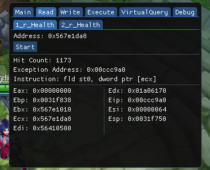Data Execution Prevention (DEP) is a system-level memory protection feature that is built into the operating system starting with Windows XP and Windows Server 2003. DEP enables the system to mark one or more pages of memory as non-executable. Marking memory regions as non-executable means that code cannot be run from that region of memory, which makes it harder for the exploitation of buffer overruns.
DEP prevents code from being run from data pages such as the default heap, stacks, and memory pools. If an application attempts to run code from a data page that is protected, a memory access violation exception occurs, and if the exception is not handled, the calling process is terminated.
DEP is not intended to be a comprehensive defense against all exploits; it is intended to be another tool that you can use to secure your application.
https://docs.microsoft.com/en-us/windows/win32/memory/data-execution-prevention
How Data Execution Prevention Works
If an application attempts to run code from a protected page, the application receives an exception with the status code STATUS_ACCESS_VIOLATION. If your application must run code from a memory page, it must allocate and set the proper virtual memory protection attributes. The allocated memory must be marked PAGE_EXECUTE, PAGE_EXECUTE_READ, PAGE_EXECUTE_READWRITE, or PAGE_EXECUTE_WRITECOPY when allocating memory. Heap allocations made by calling the malloc and HeapAlloc functions are non-executable.
Applications cannot run code from the default process heap or the stack.
DEP is configured at system boot according to the no-execute page protection policy setting in the boot configuration data. An application can get the current policy setting by calling the GetSystemDEPPolicy function. Depending on the policy setting, an application can change the DEP setting for the current process by calling the SetProcessDEPPolicy function.
https://docs.microsoft.com/en-us/windows/win32/api/winnt/ns-winnt-exception_record
EXCEPTION_RECORD
typedef struct _EXCEPTION_RECORD {
DWORD ExceptionCode;
DWORD ExceptionFlags;
struct _EXCEPTION_RECORD *ExceptionRecord;
PVOID ExceptionAddress;
DWORD NumberParameters;
ULONG_PTR ExceptionInformation[EXCEPTION_MAXIMUM_PARAMETERS];
} EXCEPTION_RECORD;ExceptionInformation
An array of additional arguments that describe the exception. The RaiseException function can specify this array of arguments. For most exception codes, the array elements are undefined. The following table describes the exception codes whose array elements are defined.
| Exception code | Meaning |
| EXCEPTION_ACCESS_VIOLATION | The first element of the array contains a read-write flag that indicates the type of operation that caused the access violation. If this value is zero, the thread attempted to read the inaccessible data. If this value is 1, the thread attempted to write to an inaccessible address.If this value is 8, the thread causes a user-mode data execution prevention (DEP) violation. The second array element specifies the virtual address of the inaccessible data. |
| EXCEPTION_IN_PAGE_ERROR | The first element of the array contains a read-write flag that indicates the type of operation that caused the access violation. If this value is zero, the thread attempted to read the inaccessible data. If this value is 1, the thread attempted to write to an inaccessible address.If this value is 8, the thread causes a user-mode data execution prevention (DEP) violation. The second array element specifies the virtual address of the inaccessible data. The third array element specifies the underlying NTSTATUS code that resulted in the exception. |
The abuse!
VirtualProtect(&addr, &size, PAGE_READONLY, &hs.addressToHookOldProtect);Set the target address into PAGE_READONLY so that if the address tries to execute/write, then it would result to an exception where we can catch the exception using VEH handler.
LONG WINAPI UltimateHooks::LeoHandler(EXCEPTION_POINTERS* pExceptionInfo)
{
if (pExceptionInfo->ExceptionRecord->ExceptionCode == EXCEPTION_ACCESS_VIOLATION)
{
for (HookEntries hs : hookEntries)
{
if ((hs.addressToHook == pExceptionInfo->ContextRecord->XIP) &&
(pExceptionInfo->ExceptionRecord->ExceptionInformation[0] == 8)) {
//do your dark rituals here
}
return EXCEPTION_CONTINUE_EXECUTION;
}
}
return EXCEPTION_CONTINUE_SEARCH;
}As you can see, you just have to compare the ExceptionInformation[0] if it is 8 to verify if the exception is caused by DEP.
Simple AF!
What can I do with this?
Change the execution flow, modify the stack, modify values, mutate, and anything your imagination can think of! Just use your creativity!
POC



Conclusion
Thanks for viewing this, I hope you enjoyed this small writeup. Its been a while since I posted writeups, and may post again on some quite time. I am now currently shifting to Linux environment, should you expect that I will be having writeups on Linux, Web, Network, and Pentesting!
I am also planning to get some certifications such as CEH and OSCP, but I am not quite sure yet. But who knows? Ill just update it here whenever I came to a finalization.
Thanks and have a good day!~
